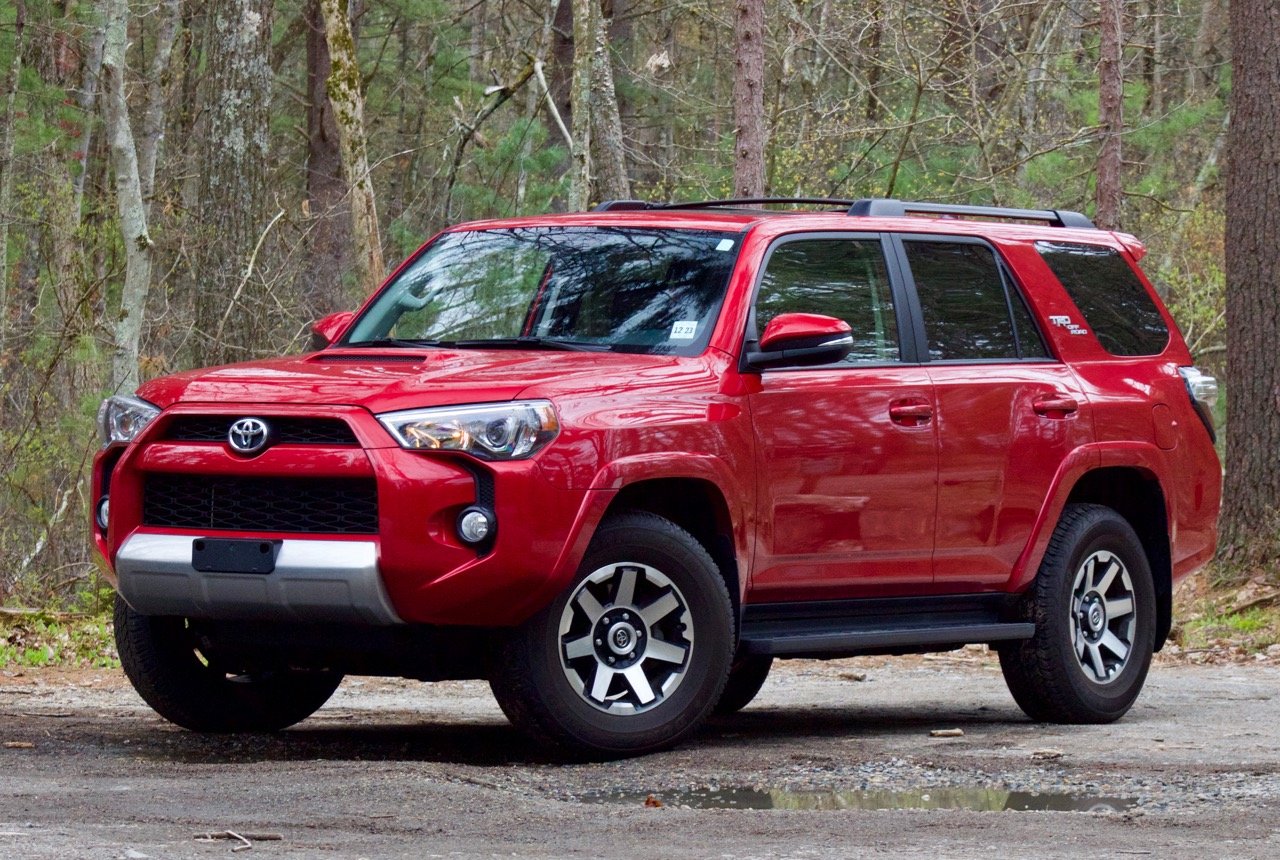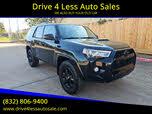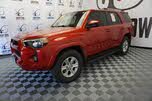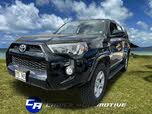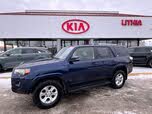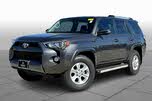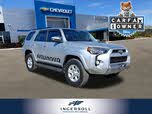2020 Toyota Sienna vs 2019 Toyota 4Runner
Overview | ||
MSRP | $35,310 | $29,715 |
Average price | $33,745 | $29,701 |
Listings | ||
Ratings & Reviews | ||
User reviews | ||
Expert reviews | 7.2 out of 10Read full review | 7.8 out of 10Read full review |
Pros & cons | Pros
| Pros
|
Summary | If you’re in the market for a modern SUV capable of getting off the beaten path, you have only a handful of options. These include the 2- and 4-door Jeep Wranglers, the Jeep Cherokee Trailhawk, the Jeep Grand Cherokee Trailhawk, the Land Rover Range Rover, and the Toyota 4Runner. Of those, only the Jeep Wrangler Unlimited and the 4Runner are 4-door SUVs that put off-road grit above all else. While the Jeep Wrangler is only one year removed from a complete redesign that brought in many new technologies, the 2019 Toyota 4Runner is based on a design first introduced in 2009. For those keeping score at home, that means the DNA underpinning the 4Runner is a decade old. Yet picking which vehicle I’d choose as a daily drivable, off-road-capable SUV is a surprisingly difficult decision. So where does an old goat like the 2019 Toyota 4Runner fit in the modern SUV market? Interestingly, the 4Runner's advanced age actually helps it in some respects. | Since the second half of the 20th century, each decade has had a hot-topic family car, and, as we’ve noted in a number of reviews this year, the crossover is our current darling vehicle. Before the crossover, there were big, truck-based SUVs. Before that, there were station wagons. And for the past 35 years, there's always been the minivan. The Dodge Caravan has been widely considered the Patient Zero of the minivan segment. From there, seemingly everyone joined the party, including Toyota, Nissan, Ford, Chevy, GMC, Volkswagen, Oldsmobile, Ford, and more. Heck, even Mercury had a “Nautica Edition” version of the Villager. The minivan was king once, the crossover is king now, and some other type of vehicle will likely dominate in the near future. But in all this, the 7- and 8-passenger minivans will always represent the ultimate in versatility. The crossover is an image-forward fad with a dash of usability, but the minivan continues to prove itself as the pinnacle of practicality. The 2020 Toyota Sienna is neither the newest nor flashiest minivan out there, but when you absolutely need space for people and gear, there’s nothing better. Additionally, the Sienna is the only minivan to offer all-wheel drive (AWD), which is something specifically desired by many car buyers. |
Video | ||
Popular Features & Specs | ||
Engine | 4.0L 270 hp V6 | 3.5L 296 hp V6 |
Drive Train | 4X2 | FWD |
Seating Capacity | 7 | 2 |
Horsepower | 270 hp @ 5600 rpm | 296 hp @ 6200 rpm |
MPG City | 17 | 19 |
MPG Highway | 21 | 26 |
Engine | ||
Engine Name | 4.0L 270 hp V6 | 3.5L 296 hp V6 |
Torque | 278 lb-ft @ 4400 rpm | 263 lb-ft @ 4700 rpm |
Horsepower | 270 hp @ 5600 rpm | 296 hp @ 6200 rpm |
Drivetrain | 4X2 | FWD |
Fuel Economy | ||
MPG City | 17 | 19 |
MPG Highway | 21 | 26 |
Interior | ||
Seating Capacity | 7 | 2 |
Safety | ||
Front Crash Overall | 4 | 4 |
Side Crash Overall | 5 | 5 |
Dimensions & Capacity | ||
Cargo Space | 47.2 cu ft | |
Curb Weight | 4400 lbs | 4375 lbs |
Height | 71.5 in | 68.9 in |
Length | 190.2 in | 200.2 in |
Width | 75.8 in | 78.1 in |
Wheelbase | 109.8 in | 119.3 in |
Maximum Payload | 1700 lbs | |
Number of doors | 4 | 4 |
Maximum Towing Capacity | 5000 lbs | |
Standard Towing Capacity | 5000 lbs | |
The 2019 Toyota 4Runner showcased a classic off-road aesthetic that was more than just for show. Unlike some modern crossovers and SUVs that imitated rugged looks, the 4Runner’s design was rooted in functionality. The 4Runner had undergone a refresh in 2015, which imbued it with a more aggressive front end, but its overall design remained a testament to its off-road capabilities. The stubby front and rear ends of the vehicle allowed for steep approach and departure angles, while the large tires and flared fenders were not just for style but to ensure the vehicle’s prowess on challenging terrains.
Trim levels for the 4Runner included SR5, SR5 Premium, TRD Off-Road, TRD Off-Road Premium, Limited, and the top-tier TRD Pro. Each variant was available in either rear-wheel drive (RWD) or four-wheel drive (4WD). The base SR5 came standard with features such as 17-inch alloy wheels, smoked-out taillights, under-body skid plates, tinted windows, and a power up/down rear window reminiscent of the first-generation 4Runner from the 1980s.
Inside, the 4Runner's design felt a bit dated, even with the mild updates introduced in 2015. The SR5 trim came equipped with an 8-way power driver’s seat, cloth upholstery, a manual 4-way front passenger seat, a leather-wrapped steering wheel, Bluetooth connectivity, and one-touch power windows. Additionally, it featured a 120-volt wall-style power outlet in the rear cargo area, underscoring its camping-friendly nature. For those seeking more amenities, the SR5 Premium trim added heated side mirrors with integrated turn signals, heated front seats, SofTex upholstery, a 4-way power front passenger seat, an auto-dimming rear-view mirror, and Entune Premium Audio with Navigation.
For off-road enthusiasts, the TRD Off-Road trim included a non-functional hood scoop, TRD Off-Road badging, a TRD shift knob, and an overhead console for 4WD functions. The TRD Off-Road Premium trim further reintroduced creature comforts like a power moonroof. The Limited trim, meanwhile, shifted focus towards curb appeal with a chrome bar across the front, 20-inch alloy wheels, and ample chrome touches throughout the exterior. The interior of the Limited trim featured real leather upholstery, dual-zone automatic climate control, and heated and cooled front seats.
For buyers who wanted a unique variant, the Limited Nightshade Edition offered the Limited package but with black accents replacing most of the brightwork. The TRD Pro, the range-topping trim, featured a black grille, TRD roof rack, TRD fog lights, matte black TRD alloy wheels, and all-terrain tires. The TRD Pro’s interior included unique floor mats and a JBL premium audio system, aligning with its rugged visuals and trail-ready upgrades like Fox Racing shocks and TRD-tuned front springs.
The 2020 Toyota Sienna, being a third-generation model introduced in 2011, revealed its age despite a 2018 update that incorporated newer infotainment technology and minor changes. Its design occasionally bordered on upscale but consistently felt dated. The sound of closing the front doors emitted a hollow thud, which wasn't a hallmark of high-quality fit and finish. Furthermore, the instrument panel seemed to come straight out of Toyota’s 2010 parts bin, although its simplicity made the controls user-friendly.
The Sienna was available in various trims including L, LE, SE, SE Premium, XLE, XLE Premium, Limited, and Limited Premium. The base L was well-equipped with 17-inch alloy wheels, remote keyless entry, three-zone climate control, five USB ports, three 12-volt outlets, Bluetooth, a WiFi hotspot, and a 7-inch touchscreen with Apple CarPlay.
The LE trim added dual power sliding doors, black roof rails, a rear bumper protector, easy-clean upholstery, manual second- and third-row sunshades, and an overhead console with controls for the power sliding second-row doors. The mid-range SE trim brought 19-inch alloy wheels, a mesh grille, fog lights, sport instrumentation, heated front seats, leather upholstery, and a power rear liftgate―a critical feature for family use.
The SE Premium trim added chrome-accented door handles with auto-locking, a power moonroof, 19-inch gunmetal alloy wheels, a DVD entertainment system for the second and third rows, and the EasySpeak intercom system for the driver. The XLE trim upgraded side rocker panels, included leather-trimmed seating, heated front seats, an upgraded instrument panel with a color center display, woodgrain accents, and one-touch power windows.
The Limited trim, which we drove, had leather front seats, leatherette second- and third-row seats, a heated and leather-trimmed steering wheel, a center console with a sliding tray, a cargo area storage compartment, a JBL premium audio system, and a navigation system. The Limited Premium trim added the DVD entertainment system, HID headlights, and rain-sensing windshield wipers. For those prioritizing a cool look, the Nightshade Edition added dark accents and dark 19-inch wheels (18 inches with AWD) to the SE and SE Premium trims.
The 2019 Toyota 4Runner had just one engine option: a 4.0-liter V6 that produced 270 horsepower and 278 pound-feet of torque, paired with an outdated 5-speed automatic transmission. This powertrain was available in either rear-wheel drive (RWD) or four-wheel drive (4WD) with a low-range option. Remarkably, the 4Runner’s V6 engine dated back to 2002 and shared more characteristics with a V8, emphasizing reliability over modern efficiency. This rugged combination allowed the 4Runner to tow up to 5,000 pounds.
The V6 engine’s V8-like characteristics enabled the 4Runner to lurch from a standstill akin to a pickup truck. Despite its loudness and substantial road noise, the 4Runner felt planted and secure thanks to its soft suspension and steering. Off-road enthusiasts could revel in the TRD Off-Road and Premium trims, which included features like a locking rear differential, Toyota's Multi-Terrain Select system, and crawl control. Multi-Terrain Select adjusted wheel slip, brake pressure, and throttle response to match trail difficulty, while crawl control acted as cruise control for rough terrains. The TRD Pro trim elevated off-road capabilities further with a reinforced front suspension, skid plates, and all-terrain tires.
Despite its off-road prowess, the 4Runner was far from efficient. Its decade-old powertrain contributed to its mediocre fuel economy, with 4WD models achieving just 17 mpg city, 20 highway, and 18 combined. RWD variants offered a marginal improvement at 17/21/18 mpg. During a week of mixed driving, a tested TRD Off-Road 4WD managed a mere 16.4 mpg.
In contrast, the 2020 Toyota Sienna was equipped with a 3.5-liter V6 engine across all trims, generating 296 horsepower and 263 pound-feet of torque, paired with an 8-speed automatic transmission. The Sienna's dash-mounted shifter included a Sport mode to enhance throttle and shift response. In normal Drive mode, the Sienna offered robust acceleration, and switching to Sport mode bolstered performance for overtaking on highways. The manual mode provided an additional driving option, though it was seldom used, and the Sienna’s towing capacity was limited to 3,500 pounds.
Power was routed to the front wheels by default, with an all-wheel drive (AWD) option available for all trims except the base L. The AWD configuration limited seating to seven passengers, making it a trade-off for consumers. Despite the growing popularity of AWD, it didn’t make the Sienna invincible in inclement weather, though it did improve acceleration and low-speed turning on ice and snow. However, it wasn’t a solution for braking on slippery surfaces.
The front-wheel-drive (FWD) Sienna achieved the best fuel economy in its lineup, with ratings of 19 mpg city, 26 highway, and 21 combined. AWD variants were slightly less efficient, returning 18/24/20 mpg. During a week of mixed driving, we observed a combined fuel economy of 18.3 mpg.
The Sienna’s low center of gravity and broad base afforded it surprisingly decent handling dynamics for a minivan. It navigated corners well and handled bumps smoothly, providing a comfortable ride without compromising its handling abilities. However, its twitchy steering response at higher speeds required constant attention to maintain a straight path on highways, posing a challenge for busy parents driving with distracted children.
The 2019 Toyota 4Runner offered a fully enclosed cabin, providing significant interior space and comfort. The front seats provided ample head- and legroom, especially noticeable for taller drivers who found the Jeep Wrangler’s front-seat legroom tight. Even with the front seats reclined, the 4Runner’s second-row space remained generous.
Although the 4Runner's interior dated back several years, its simplicity had some benefits. The 6.1-inch touchscreen may have been small, but the large knobs were easy to manipulate while wearing gloves, geared towards outdoor enthusiasts. Cargo space was the 4Runner’s standout feature, boasting nearly 90 cubic feet of space with the rear seats folded down, rivaling the Chevy Tahoe and vastly surpassing the Jeep Wrangler Unlimited’s 72 cubic feet due to the latter's roll cage and convertible top.
The 2020 Toyota Sienna excelled in interior space, a critical aspect for minivans. It provided an impressive 150 cubic feet of cargo space, surpassing competitors like the Chrysler Pacifica (140.5 cubic feet), Honda Odyssey (144.9 cubic feet), Dodge Caravan (143.8 cubic feet), and Kia Sedona (142 cubic feet). However, achieving the full cargo capacity required the complete removal of the second-row seats, which was easier with second-row captain’s chairs but cumbersome with a second-row bench. Unlike the Sienna, the Pacifica’s second- and third-row Stow-N-Go seats seamlessly folded into the floor.
Despite this, the Sienna’s third-row seats did fold seamlessly into the floor. Accessing the third row could be challenging, as the second-row seats' folding mechanism was a bit awkward. A more practical approach might be to maneuver past the second-row captain’s chairs.
Toyota also catered to buyers with mobility needs by offering Toyota's Auto Access Seat―a built-in rotating lift seat available as an upgraded trim of the Sienna, making it easier for consumers to find an accessible vehicle at an affordable price.
The 2019 Toyota 4Runner offered basic tech features, notably absent were modern infotainment systems like Apple CarPlay and Android Auto, which Toyota only began incorporating into its latest vehicles. For those who preferred simpler controls over complex touchscreens and menus, the 4Runner’s straightforward system might have been a relief. Despite the small fonts, the system was familiar and had been around for years.
The SR5 Premium we tested featured the upgraded Entune system with navigation and Siri Eyes Free, which integrated well with modern smartphones. Without CarPlay, navigation was only accessible through the Entune system.
The 2020 Toyota Sienna came equipped with a 7-inch touchscreen infotainment system across all trims, featuring Toyota’s proprietary software, Amazon Alexa, and the long-awaited Apple CarPlay. Standard tech features included Bluetooth connectivity, five USB ports (one for connectivity, the others for charging), and a WiFi hotspot with a 6-month trial subscription.
Regardless of the trim, the Sienna maintained a consistent 7-inch touchscreen, with feature variations depending on the trim. The Limited trim we tested included navigation and a JBL 10-speaker premium audio system. This trim also featured Driver Easy Speak, an intercom system that allowed the driver to communicate with rear passengers without raising their voice, enhancing the vehicle’s family-friendly aspects.
The 2019 Toyota 4Runner’s safety features were a snapshot of a bygone era. It included a full array of airbags, traction control, and a reversing camera, the latter likely due to regulatory requirements rather than a commitment to modern safety standards. The absence of driver-assistance features―now standard on even entry-level vehicles like the Toyota Corolla―was significant, making the 4Runner less family-friendly. It received an overall safety rating of 4 out of 5 stars from the National Highway Traffic Safety Administration (NHTSA), with a concerning 3 out of 5 in the rollover test.
Conversely, the 2020 Toyota Sienna came with the Toyota Safety Sense (TSS-P) suite as standard, addressing the minivan’s twitchy steering with features like lane-departure warning and lane-keep assist. TSS-P also included forward-collision warning and avoidance with pedestrian detection, dynamic cruise control, and automatic high beams. Lower trims offered optional blind-spot monitoring, but it was standard on XLE and Limited trims. The Sienna earned a commendable five stars in NHTSA crash testing and received Good ratings in various crash categories from the Insurance Institute for Highway Safety (IIHS). Its standard driver-assistance features also earned a top rating of Superior from the IIHS.
CarGurus highlights

According to CarGurus experts, the overall rating for the 2019 Toyota 4Runner is 7.2 out of 10, while the 2020 Toyota Sienna scores 7.8 out of 10. Based on these ratings, the 2020 Toyota Sienna emerges as the superior choice. While the 4Runner excels in off-road capabilities and rugged reliability, the Sienna offers better technology, safety, and interior functionality, making it the more well-rounded option for most consumers.
Choose the 2020 Toyota Sienna if:
Shop Now- You prioritize advanced safety features and driver assistance technologies for family trips.
- Greater fuel efficiency and decent handling are essential, particularly for city and highway driving.
- Ample cargo space and a practical interior layout are vital for transporting children and their belongings.
Choose the 2019 Toyota 4Runner if:
Shop Now- You value proven reliability with rugged off-road capabilities.
- You need a vehicle that can seamlessly transition from daily driving to challenging terrains.
- Interior space and cargo capacity are critical for your outdoor adventures and gear.

By: CarGurus + AI
At CarGurus, our team of experienced automotive writers remain at the heart of our content operation, conducting hands-on car tests and writing insightful guides that are backed by years of industry experience. To complement this, we are harnessing AI to make our content offering more diverse and more helpful to shoppers than ever. To achieve this, our AI systems are based exclusively on CarGurus content, ratings and data, so that what we produce is both unique to CarGurus, and uniquely helpful to car shoppers.
